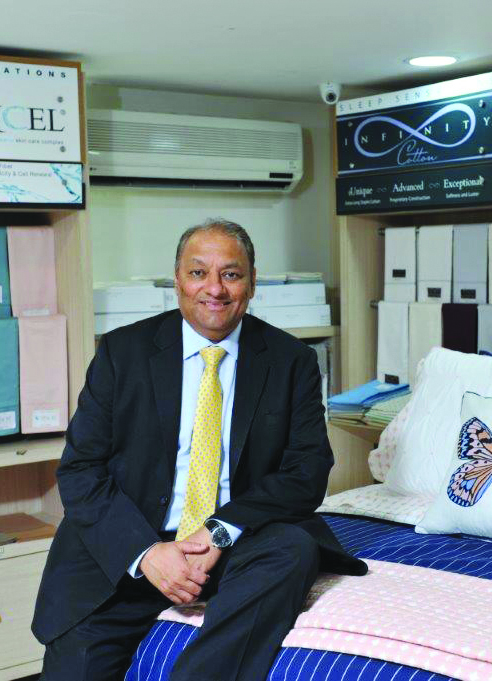
In conversation with Ground View, Mr K K Lalpuria, ED – Indo Count, talks about journey so far and the road ahead. The company is promoted by Mr Anil Kumar Jain and supported by Managing Director, Mr Mohit Jain. It was a cotton-spinning company in 1991 and set up its home textiles facility in 2007-08 focusing on export of bed linen. It went through a difficult phase during the global financial crisis and the company entered CDR because of derivative losses, but it worked its way through the pain by increasing its product visibility and reputation. It successfully exited CDR in March 2015, four years ahead of schedule and is currently the 11th largest home textile supplier and third-largest bed sheets supplier to the USA.
The textile sector has been India’s forte since centuries. We have an evolved and well-established textile value chain, which makes it easier for us to expand and scale up as well as customise products. India is in a sweet spot as various factors are working to her advantage. Firstly, for any manufacturing business, raw material availability is critical. We are blessed in that regard as India is the biggest exporter of cotton. We have abundance of good quality cotton which mitigates risks associated with availability as well as the logistics of importing the commodity. Secondly, textiles need abundant and skilled workforce. India is in a favourable position in both these aspects. As exporters, in our democracy, political stability benefits us immensely as stability of policies, strong law and order, and conducive business environment help us increase our market share globally. Comparatively, within textiles, home textiles industry is a young industry. We believe there are a lot of opportunities and untapped markets awaiting the Indian players. Domestically, with rising per-capita income and improving lifestyle, the Indian consumer too is evolving.
Indian home textiles is a major exporter and forex generator. Since Indo Count is completely export-oriented, macro global factors (weather, social, economic, and political) affect our business and the sector. New technology needs to be introduced continuously to upgrade products as well as new techniques to serve the customers. Our sector does face certain challenges such as raw material, global trade pacts, and currency fluctuations, given the global nature of our business. Raw material – cotton being an agro-based global commodity fluctuates in price due to demand-supply, which results in price volatility, and at times, availability constraints. Global trade pacts: Various trade pacts between different countries throw up new dimensions to world trade. In some countries, protectionism through tariffs compels us to find different ways to promotion. In Europe both Pakistan and Bangladesh have duty advantage, which India does not have. We pay 9.6% additional duty charges while both those countries do not. Therefore, we face headwinds in these markets and become non-competitive in comparison to these nations. Currency fluctuation: Fluctuation in currency needs efficient management and requires us to constantly monitor the dynamic situation in this field.
The competitiveness of Indian textiles is hampered by rising operational costs and poor infrastructure support. Growth in exports requires huge investments, and if tax benefits are provided, we can reinvest our profits both for growth and competitiveness. This will result in expansion of our exports base, which would in turn earn valuable forex for the country.
The EU is one of the biggest markets for home textiles, but given its fragmented nature, it is a difficult one. As the EU is made up of many countries, each with its own cultural preferences as well as varied consumer tastes and size specifications, this market has been challenging in comparison to the biggest ‘single country’ market – USA. Nevertheless, growing interest and awareness amongst consumers for cotton home textiles as well as increased traction in the mid-high segment of bed home textiles has made EU an exciting and promising market for us.
Cotton is a global commodity with price volatility being a global phenomenon. We believe there is more than sufficient supply of cotton in India. India’s position as the world’s biggest cotton producer is hugely advantageous for the Indian textiles industry. We do not see any cause for concern over raw material supply in India. Although India is the biggest producer of cotton with a comfortable ‘stock-to-end-use’ ratio, the average yield in India has yet not reached optimum levels. At ~521kg/hectare (yield in India) the country has immense scope for improvement in comparison to average global cotton yields at ~735kg/hectare. The recent spike in cotton prices in India can be attributed to local factors such as impact of demonetisation. Globally, we believe cotton prices would remain stable and range bound with an increase of 2-3% for the year.
The bed-linen segment of home textiles is in a nascent stage. India is poised to achieve quantum growth in this sector on various advantages such as raw material availability, skilled and cost-effective labour, and well-established textile value chain, as compared to other countries. We believe there is a huge market out there yet untapped by Indian players. The pie is big enough for all players to grow at a good rate.
Subscribe to enjoy uninterrupted access